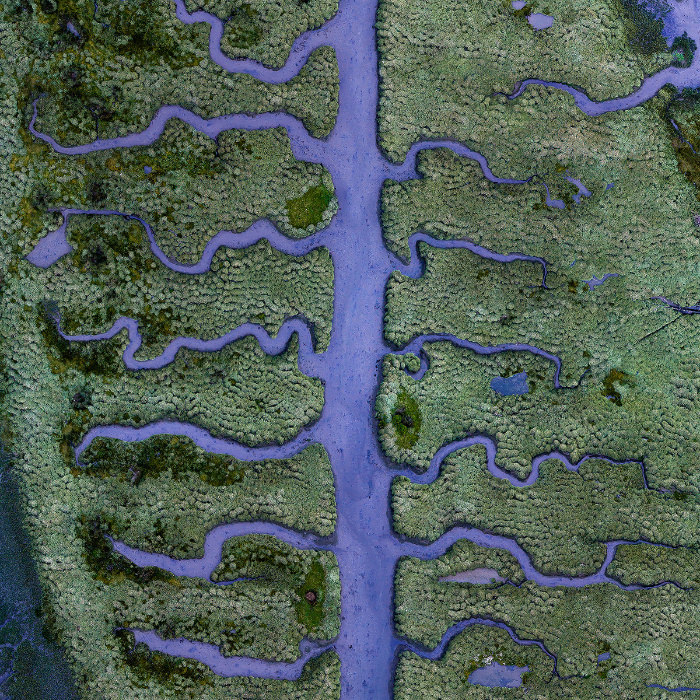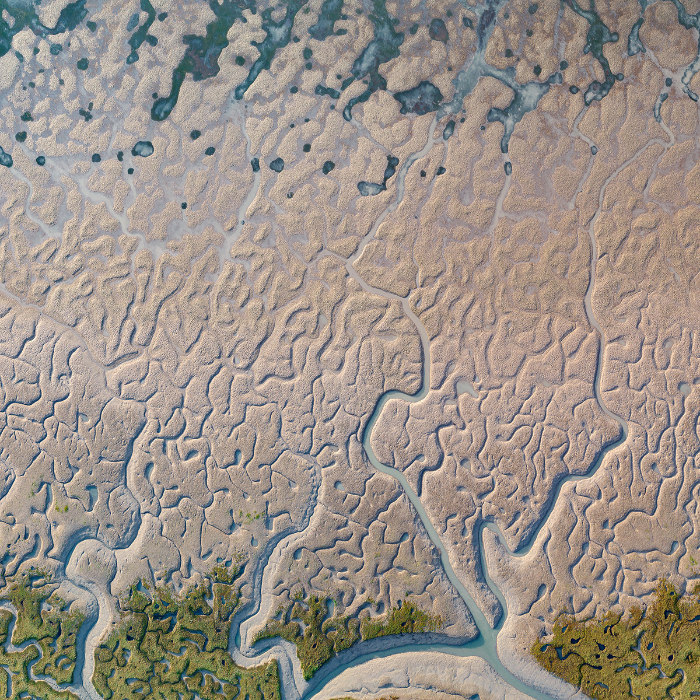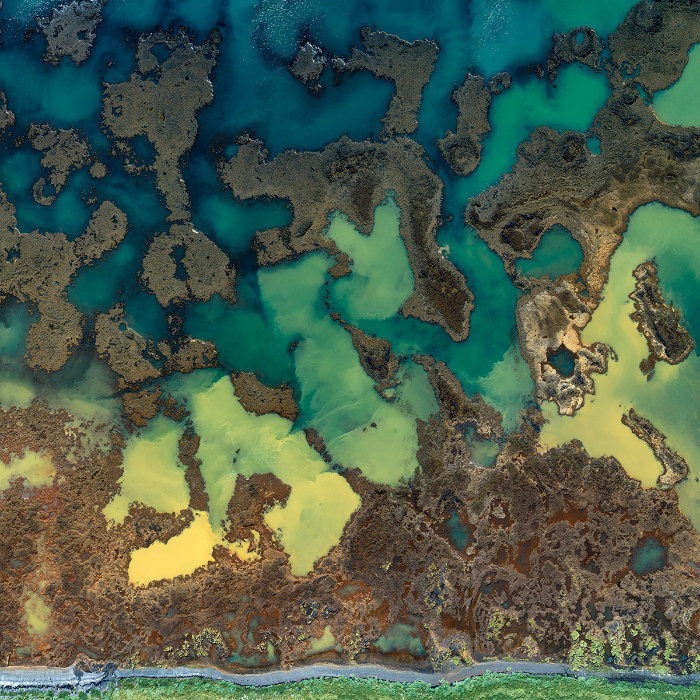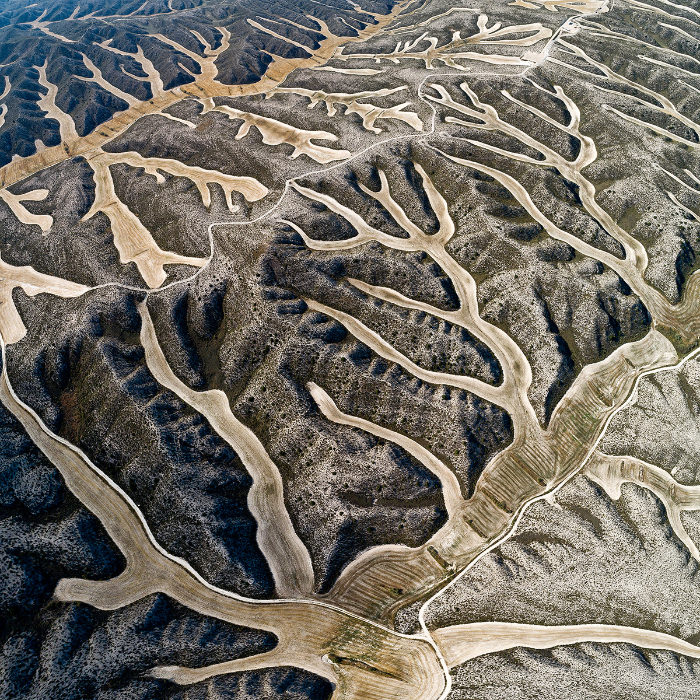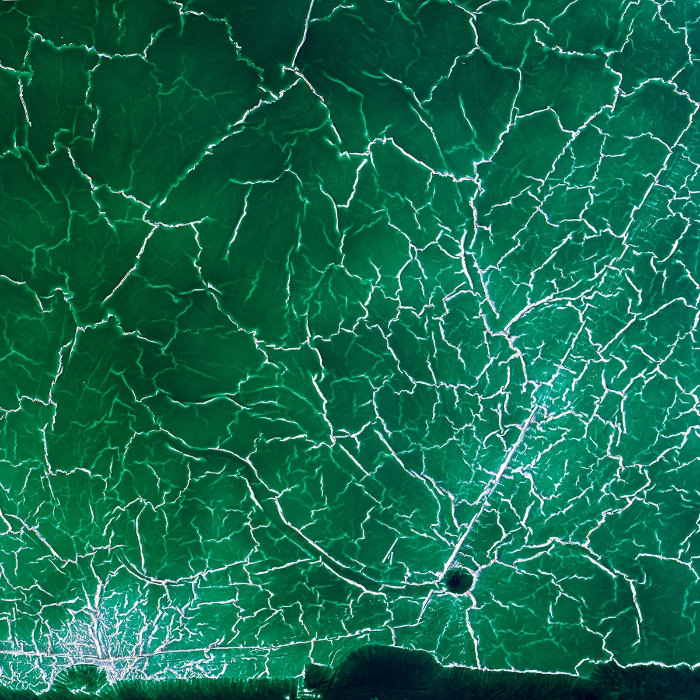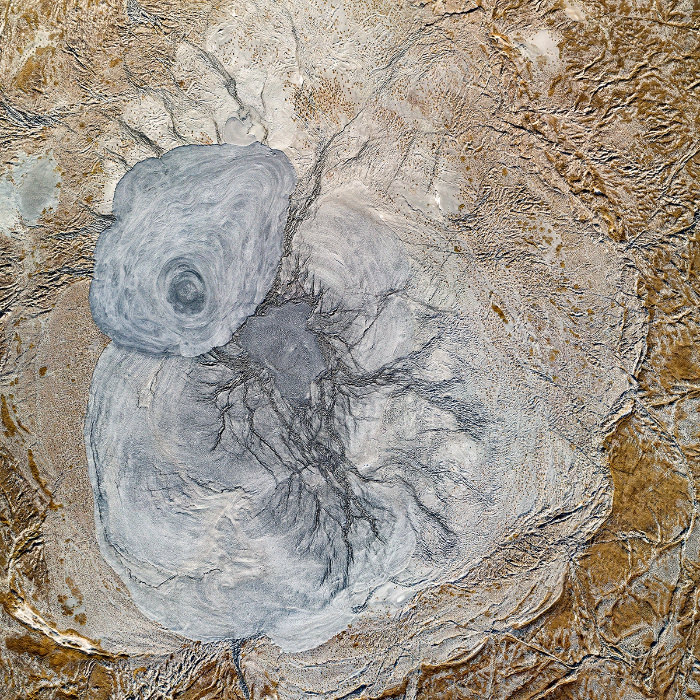
Conozca Water.Shapes.Earth. Los fundadores del sitio web creen que un punto de vista aéreo revela el verdadero carácter de los paisajes, a menudo desconocido para los que están en el suelo y los ven a nivel de los ojos. Como dicen en su página web, su "objetivo es abrir nuevas perspectivas mientras comparten historias, revelan lugares y cambian un poco las mentes". Les fascina cómo el agua da forma al planeta Tierra, creando patrones y colores abstractos. Aquí compartimos 10 fotografías del fundador y fotógrafo húngaro Milan Radisics.
Isla de los pantanos, Italia Fuente
Fuente
El mayor humedal del Mediterráneo se encuentra en la Laguna de Venecia (Italia). Está compuesto principalmente por marismas. Gracias a las crecidas de las mareas, que aportan la cantidad justa de nutrientes, agua y oxígeno con cada marea, estas marismas se encuentran entre los ecosistemas más productivos del mundo. El resultado es la colorida hierba que puedes ver en la foto.
Marisma salada, España
Esta floreciente marisma cerca de La Coruña, España, está situada en el extremo de la ría de Betanzos. Hasta el siglo XVIII, el puerto de Betanzos fue un importante centro pesquero y comercial. Las singulares formas de éste fueron posiblemente influenciadas por los estanques de pesca hechos por el hombre que cubrían la zona hace siglos. Se supone que están influenciadas por una actividad realizada por el hombre porque sólo aparecen en una parte pequeña de la marisma.
Formas de arena, España
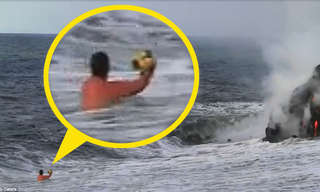
¡El Violento Encuentro Entre El Fuego y El Agua!
Este compilado nos muestra las impactantes imágenes del momento en el que la lava se encuentra con el agua.
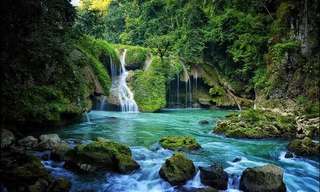
30 Hermosos Ríos Que Despertarán Tu Espíritu Viajero
El esplendor del agua en la forma de un río.
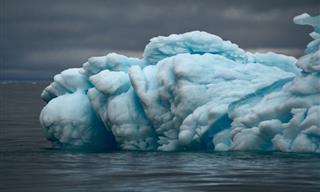
Un Día Interminable En Groenlandia - ¡Maravilloso!
Visita Groenlandia, hogar del glaciar más estudiado y activo de la historia: el glaciar Jakobshavn.

Las 14 Fotografías Más Hermosas De La Naturaleza Del 2024
Aquí están los ganadores del concurso Fotógrafo de la Naturaleza del Año 2024.
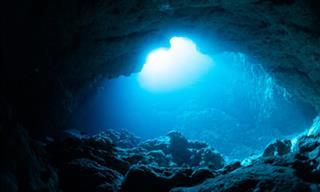
El Océano Más Grande Del Mundo ¿Está Bajo La Tierra?
Un descubrimiento innovador realizado por investigadores revela una enorme reserva de agua en las profundidades de la superficie de la Tierra.
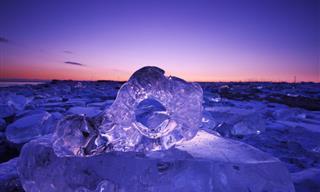
Contempla Las Joyas De Hokkaido, Japón
Contempla las "joyas de hielo" del río Tokachi, en Hokkaido (Japón), el único lugar donde se puede admirar este raro fenómeno.

8 Alimentos Pueden Ser Peligrosos Si Se Comen En Exceso
Los reconocidos expertos en salud dicen que algunos alimentos, a pesar de ser saludables en general, pueden ser seriamente dañinos cuando se ingieren en grandes cantidades.
 10:42
10:42
Descubre Qué Tan Saludables Son Las Freidoras De Aire
Descubre los mitos y verdades sobre el uso de las freidoras de aire.
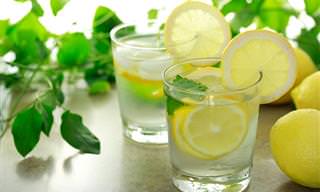
¿Vas a Un Restaurante? Cuidado Con El Agua Con Limón...
Después de leer este artículo, puede que te lo pienses dos veces antes de beber agua con limón en un restaurante.
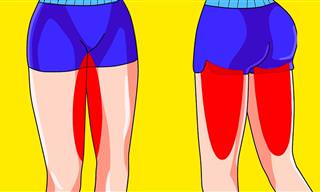 16:22
16:22
Dos Ejercicios Para Fortalecer Tus Piernas En Una Semana
Hemos preparado una rutina para ti: sólo necesitas hacer DOS ejercicios al día para fortalecer tus piernas.
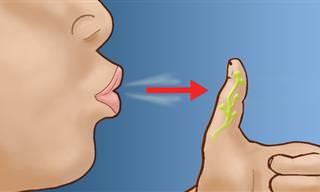
Elimina El Dolor y El Estrés Con Estos Inusuales Remedios
Los medicamentos son útiles en ocasiones pero también tienen efactos secundarios. Si eres de los que apuesta por remedios naturales, aquí te presentamos 6 remedios alternativos para curar el dolor o reducir el estrés.
 2:39
2:39
Esta Es Una De Las Infecciones Oculares Más Comunes
Conoce cuales son los principales signos de una conjuntivitis bacteriana y qué puedes hacer para tratarla.

Estudio Sobre Las 15 Comidas Más Adictivas
Los investigadores de la Universidad de Michigan han profundizado en este tema y han elaborado una lista autorizada de los alimentos más adictivos que existen.
 7:23
7:23
Si Tienes Hernia De Disco, Esto Es Lo Que Necesitas
Estos ejercicios te ayudarán a aliviar los síntomas de la hernia discal disminuyendo la tensión en todas las articulaciones y regiones adyacentes.

¿Comes Huevos Diariamente? Por Estas razones Debes Hacerlo
Por estas 10 razones deberías comer huevos con regularidad. ¿A qué estás esperando?

Esta Técnica Puso Fin a Mi Dolor De Cuello y Hombros
Es sorprendente la cantidad de tensión que se acumula en nuestro cuerpo en sitios tan dispares como las manos. Por esta razón es tan útil ejercitar estos puntos de presión.
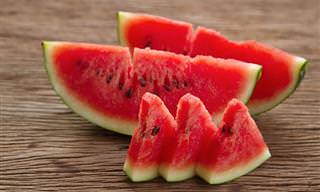
12 Diuréticos Naturales Que Desinflaman
Si tienes el estómago hinchado, debes probar algunos de estos diuréticos naturales recomendados por los médicos.
 19:28
19:28
¿Es Peligroso Sentir Dolor En El Brazo Izquierdo?
Generalmente el dolor en el brazo izquierdo no representa un motivo de preocupación, sin embargo, en ocasiones puede tratarse de un problema más severo y por estas razones hay que poner atención.
 11:39
11:39
Nutrióloga Explica Cuáles Son Los Helados Más Saludables
En este video, la nutrióloga Mónica Acha analiza lo bueno, lo malo y los mitos que al consumo de helados.

¿Deberíamos Tirar Los Medicamentos Viejos?
En este artículo, explicamos por qué es importante deshacerse de los medicamentos viejos, vencidos y sin usar y cómo hacerlo de manera segura.

Prueba Estos 9 Métodos Para Reducir El Dolor
Descubre cómo reducir tu dolor utilizando el poder del pensamiento y de forma natural: ¡realmente funciona!

Plancha Abdominal: Postura Del Oso Para Tu Abdomen
Aquí, explicaremos los beneficios de la postura de la plancha del oso y presentaremos 5 versiones diferentes para aquellos que buscan reducir o aumentar la intensidad del ejercicio.

Guía: Cómo Manejar La Diabetes En La Edad Madura
Este artículo tiene como objetivo explorar la naturaleza multifacética de la diabetes en adultos mayores y proporcionar soluciones prácticas e integrales para las personas mayores con diabetes para manejar su enfermedad.

¿Cuándo Se Necesita Un Reemplazo De Cadera?
La cirugía de reemplazo de cadera puede aliviar el dolor, restaurar la función de la cadera y mejorar la movilidad y la calidad de vida.
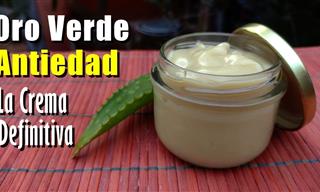 14:06
14:06
Usa Este Remedio Ancestral Para Las Manchas En La Piel
A continuación te presentamos un remedio ancestral a base de té verde para que tu piel luzca hermosa y sin manchas.
 4:51
4:51
Consejos Ideales Para Aliviar Las Molestias En El Coxis
En este video el fisioterapeuta Julio nos brinda sus mejores consejos para las personas que padecen problemas en el coxis, lo primero que tienes que hacer es conseguirte una dona y usarla cuando vayas a sentarte para que los síntomas disminuyan.
 14:10
14:10
3 Frutas Que Deberías De Consumir Después De Los 60
Mantente saludable y feliz después de los 60 con estas increíbles frutas.

Hábitos Asiáticos Saludables Para Incorporar a Tu Vida
No es un secreto que en los países asiáticos cuentan con rutinas de salud y belleza tradicionales que han llevado a gran parte de la población a gozar de una esperanza de vida envidiable. A continuación te presentamos algunos de estos secretos.
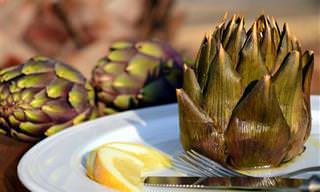
¿Hojas De Alcachofa? Te Damos Razones Para Consumirlas
Aunque los corazones de alcachofa son la parte principal que consumimos, se recomienda que también comiences a comer las hojas, que contienen la mayoría de los nutrientes importantes de la verdura, incluida una gran cantidad de antioxidantes.
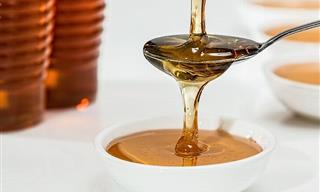
Lo Mejor De La Miel En 7 Saludables Posts
La miel ha estado presente en la dieta humana por millones de años. No olvides hacer de la miel un hábito diario en tu dieta alimentaria y en tu vida en general.
 10:08
10:08
Come Avena a Diario y Mira lo que Pasa
Las fantásticas propiedades de este cereal te ayudarán a sentirte y verte mejor, tanto por dentro como por fuera, ya que es rico en minerales y vitaminas.
 14:26
14:26
¿Cómo Aumentar Naturalmente La Testosterona?
En la actualidad, muchas personas tienen niveles bajos de testosterona en su organismo, y el doctor De la Rosa nos dice cómo lograr aumentar la testosterona de manera natural.
 7:50
7:50
Hierbas y Especias Que Pueden Acelerar La Pérdida De Peso
El doctor Frank Suárez especialista en obesidad y metabolismo, nos presenta en esta ocasión sus recomendaciones de hierbas y especias que pueden ayudar a la reducción de peso.

Piel radiante con la tradición oriental de la cuchara
¿Crees que una simple cuchara puede ayudar a rejuvenecer la piel de tu rostro? Las mujeres chinas lo practican diariamente. Interesante, ¿verdad? Sigue leyendo y descubre como rejuvenecer tu piel.

¿Cómo Reducir Las Posibilidades De Ataques Al Corazón?
Cuando se trata de enfermedades cardíacas, los franceses, japoneses y coreanos tienen las tasas más bajas del mundo. ¡Te contamos el secreto!

Subvariante COVID-19 "Sigilosa" - ¿Qué Es?
¿Es la supuesta nueva subvariante "furtiva" COVID-19 de Omicron realmente capaz de evadir las pruebas actuales?

Aprende a Limpiar y Desintoxicar Tus Pulmones
Los pulmones son una parte muy importante de nuestro organismo. En este artículo te damos 10 consejos para aprender a mantenerlos limpios y sanos de manera natural.
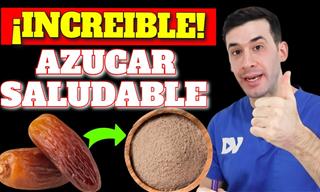 11:40
11:40
Este Dulce Fruto Seco Es Uno De Los Mejores Para Tu Dieta
Los dátiles no sólo son un refrigerio delicioso; ¡también pueden ayudar a controlar el nivel de azúcar en sangre!

7 Posts Que Debes Leer Si Tienes Hipertensión
Muchas personas ni siquiera saben que tienen presión arterial alta. Si no se trata, esta condición puede dañar silenciosamente el corazón, los pulmones, los vasos sanguíneos, el cerebro y los riñones, por eso se le llama el "asesino silencioso".
 3:52
3:52
¿Cuáles Son Los Principales Signos De Un Aneurisma?
Muchas personas no saben qué es un aneurisma cerebral, aunque es una afección muy común. Aquí te explicamos qué necesitas saber y cómo detectarlo.
 11:08
11:08
No Botes La Cáscara De La Cebolla. Te Contamos Qué Hacer
¡No botes la cáscara de cebolla! En este video revelamos para qué sirve el té de cebolla en ayunas, y los mejores beneficios para tu salud y belleza. ¡No te lo pierdas!
 14:20
14:20
Yoga Suave Para Despertar Con Bienestar
Prueba esta secuencia de 15 minutos de yoga al despertar para comenzar el día de manera agradable y como se merece.
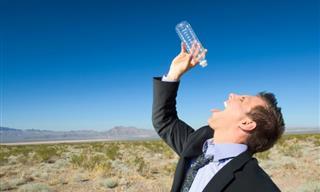
Las Principales Causas Por Las Que Sientes Demasiada Sed
¿Cómo saber si la sensación constante de sed indica un problema de salud?

12 Alimentos Que Mejoran La Circulación Sanguínea
12 de los mejores alimentos que la naturaleza puede ofrecerte para mejorar el flujo sanguíneo.

Recomendaciónes Para Tratar Las Venas Varicosas
Las várices y la flebitis no sólo tienen muy mal aspecto, sino que ambas son bastante dolorosas, a continuación te vamos a dar algunos consejos para prevenir, lidiar y mejorar las várices.
 8:59
8:59
Huevos: Energía, Defensa y Bienestar
¿Cuáles son los beneficios de comer huevos? ¡Estamos a punto de contártelo! De hecho, este producto está equilibrado por la propia naturaleza. Contiene una gran cantidad de vitaminas y elementos importantes.

¿Cuál Es La Relación Entre La Salud Intestinal y El Plátano?
¿Sabías que las bananas pueden ser excelentes para la salud intestinal? Averigüemos más.
 32:06
32:06
Rutina De Tai Chi Con Pelota Para Tu Columna Vertebral
El experto en Tai Chi y Qi Gong Luis Duarte nos trae en esta ocasión una rutina especial para la columna que se realiza con la ayuda de una pelota. Estos ejercicios también son buenos para ejercitar tu cerebro y para mejorar tus niveles de energía.
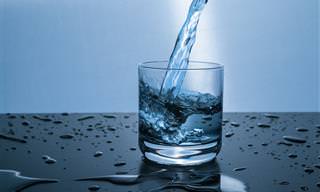
Beneficios Sorprendentes de Beber Solo Agua
Si no bebes agua durante 3 a 5 días morirás, pero ¿qué sucede si solo tomas agua como bebida principal? Estos grandes beneficios suceden, ¡Aqui tienes el por qué!

Razones Agradables Para Disfrutar Tu Cerveza
Lo creas o no la cerveza tiene grandes beneficios para tu salud. Te presentamos 10 beneficios que el consumo de esta bebida tan popular puede ofrecerte.
 3:49
3:49
Acaba Con Los Dolores De Cuello y Hombro
En este video, te mostraremos cómo aliviar esos dolores practicando un auto-masaje en el área afectada. Relájate durante el procedimiento.
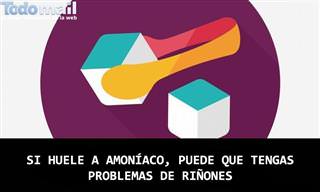
Tu Cuerpo Habla: Escúchalo En 60 Segundos
Si tienes miedo de ir al médico, o temes tener un problema de salud grave, este truco fácil y rápido te ayudará a identificar si tienes problemas de salud.

9 Alimentos Ricos En Omega 3 Que Debes Conocer
Existen ciertos tipos de grasas que son beneficiosas para la salud de nuestro organismo, como es el caso del omega 3. Si quieres conocer alimentos ricos en este nutriente, haz clic aquí.

¿Cómo Bajar Los Niveles De Colesterol Dañino?
Esta práctica guía te ayudará a bajar los niveles de colesterol, una de las causas más comunes del padecimiento de ataques al corazón en el mundo occidental.

Jugo de Zanahoria: Energía Natural Para Tu Día
Si no eres consciente de las propiedades que tiene un vaso de jugo de zanahoria, presta atención a este artículo. Prueba esta rica receta y conoce los beneficios que puede ofrecerte.

Café: 17 Detalles Que Casi Nadie Conoce
¿No puedes comenzar el día sin una taza de café? Así que para ti, que eres amante del café, te contamos cosas que no sabías sobre esta popular bebida...
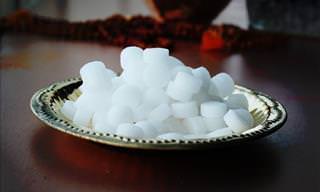
Alcanfor: Guía, Usos y Consejos Beneficiosos
El alcanfor es uno de los ingredientes principales que le da a Vicks VapoRub su fuerte olor y capacidad descongestionante. ¡Tiene muchos otros beneficios y te presentamos 10 de ellos!

10 Alimentos Que NO Debes Comer Para El Desayuno
El desayuno es la comida más importante del día, pero es tan importante saber qué comer como saber qué evitar. ¡Averigua más aquí!

Un Rico Licuado Para Dormir a Pierna Suelta
¿Te cuesta conciliar el sueño por las noches? Prepara este saludable licuado y comienza a despertarte fresco todas las mañanas.
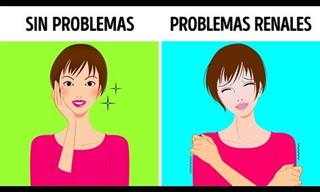 10:24
10:24
Cómo detectar cambios en la salud renal
Aquí tienes algunos de los síntomas menos obvios que pueden indicar que tus riñones necesitan ayuda. Si tienes alguno de ellos, es una buena razón para ver a un médico.
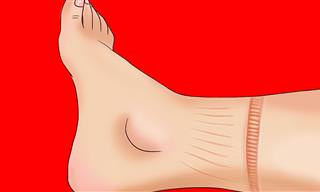 10:40
10:40
¿Cómo Estás Del Corazón? 10 Advertencias Sobre Su Salud
Tu cuerpo da señales y advertencias sobre el corazón para que puedas prevenir las enfermedades a tiempo...

Las Pruebas Médicas Esenciales Después de Los 50
Ahora que has llegado a la "edad media", 50-60 años, asegúrate de que mantener una buena salud. Pregunta al doctor sobre estas pruebas médicas y hazte una revisión completa.

Dormir Así Puede Mejorar Tu Salud
La posición que elegimos para dormir afecta a nuestra salud más de lo que pensamos. Conoce los 6 beneficios para la salud que supone dormir del lado izquierdo.

Naranja tibia: tu aliada contra la to
¿Te resfriaste y la tos te está matando? Prepara una naranja al vapor con sal. Sentirás un alivio inmediato en pocos minutos.

¿Qué Medicamentos Caducados Siguen Siendo Seguros?
Ciertos tipos de medicamentos todavía pueden consumirse incluso 40 años después de su fecha de vencimiento. Descubre cuáles son...
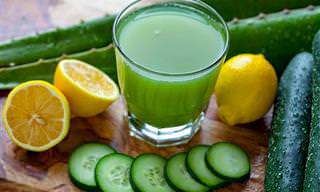
Duerme Mejor y Adelgaza con Este Jugo Verde
Sería increíble poder bajar de peso rápidamente con una simple bebida y por supuesto algunos ejercicios. Puede sonar difícil de creer, pero hay una manera de quemar grasa y bajar de peso rápidamente y fácil.

5 Sencillas Rutinas Para Poner Fin Al Dolor De Rodillas
Nuestras rodillas son las articulaciones más propensas a sufrir lesiones, debido al uso intensivo diario. Estos simples ejercicios te ayudarán a reducir el dolor.
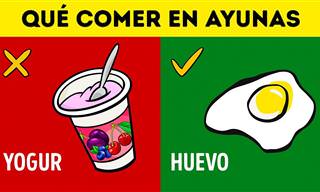 6:03
6:03
El Secreto de un Buen Comienzo Cada Mañana
¿Quieres saber qué comida es mejor para ti por la mañana? Estos son los 20 alimentos que debes evitar y los que debes comer con el estómago vacío.
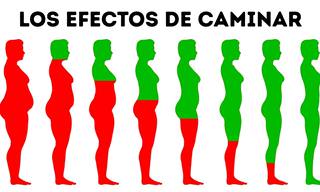 11:37
11:37
Beneficios De Caminar A Diario
Es sano, gratis y sencillo: ¡caminar! Requiere poco esfuerzo y es tremendamente beneficioso para tu salud mental y física. Compartimos 10 de sus fantásticos efectos.

Lo que no sabías de las semillas de sandía
¿Eres de los que huyen de las semillas de sandía? Te sorprenderán saber los beneficios de estas semillas para la salud y los sabrosas que son cuando se tuestan.

Nueva Luz para Mejorar la Memoria en Alzhéimer
El año 2015 supuso un gran avance en el tratamiento del Alzheimer. Investigadores australianos desarrollaron una tecnología de ultrasonido no invasiva. Esperemos que este año pueda probarse dicho tratamiento en seres humanos.

Domina La Cocina Con Estos 7 Recursos
¿Quieres convertirte en un auténtico chef en tu propio hogar? Te presentamos 7 infografías con los mejores trucos para mejorar tus habilidades culinarias.

Cinco alimentos que cuidan tu mente
Te detallamos 5 alimentos que, según la medicina, son muy efectivos para mantener a raya el Alzheimer y la demencia.
 7:34
7:34
Mejora o Evita Los Dolores En el Nervio Ciático
La ciática, cuando no es causada por una hernia discal puede deberse a la presión que ejerce uno de los músculos del glúteo (el piriforme) sobre el nervio ciático. Aquí tienes 3 maneras muy eficaces de evitar esa dolencia o acabar con el dolor.

10 Prácticas Repugnantes En La Industria Alimentaria
¿Sabías que estas cosas continúan en la industria alimentaria? Te contamos 10 prácticas alimenticias bastante repugnantes que debes conocer.

El Horrible Secreto De La Industria Del Azúcar
Una nueva evidencia ha demostrado que la industria azucarera ocultó la investigación científica que vinculaba el azúcar a las enfermedades cardíacas y el cáncer de vejiga en ratas.

Cabeza Clara con Jugos Naturales
Los dolores de cabeza se producen por la deshidratación. Estas recetas que te presentamos a continuación contienen estos tres minerales que ayudarán a combatir el dolor: potasio, calcio y magnesio.

Piel radiante con la tradición oriental de la cuchara
¿Crees que una simple cuchara puede ayudar a rejuvenecer la piel de tu rostro? Las mujeres chinas lo practican diariamente. Interesante, ¿verdad? Sigue leyendo y descubre como rejuvenecer tu piel.

Estas señales podrían venir del hígado
El hígado es uno de los órganos más importantes del cuerpo humano,así que es importante que sepas cuándo no funciona correctamente. ¡Presta atención a los siguiente síntomas!

3 Razones Para No Reutilizar Botellas Plásticas
Beber directamente de una botella es rápido y fácil, aunque en realidad hay varias razones por las que no debes hacerlo. Sigue leyendo para averiguar los porqués.
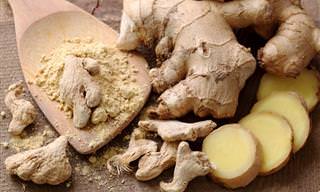
Cuidado Con El Jengibre Si Tienes Estas Condiciones
El jengibre es una maravilla, pero para algunas personas es demasiado potente. Averigua si es seguro para que ti y disfruta de los indudables beneficios de esta raíz.

Miel: el remedio natural que necesitas
La miel ha estado presente en la dieta humana por millones de años, y no es para menos, pues gracias a los increíbles beneficios que tiene para la salud, es uno de esos productos que no puede faltar en nuestra dieta diaria. Aquí te dejamos 9 recetas.


